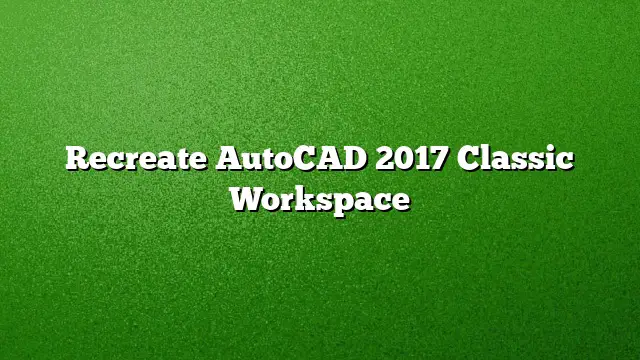Understanding the AutoCAD Ribbon Interface
The AutoCAD Ribbon interface offers a modern, streamlined way to access tools and features that enhance productivity. Although some users have become accustomed to the Classic workspace, transitioning to the Ribbon interface unfolds a wealth of benefits designed to optimize your design workflow.
Why Recreate the Classic Workspace?
For those who prefer the traditional menu and toolbar layout, it is understandable to desire the look and feel of the AutoCAD 2025 Classic workspace. While the Classic workspace is no longer included by default, it’s possible to set up a similar environment through a few straightforward steps.
Step-by-Step Guide to Recreating the Classic Workspace
Step 1: Accessing the AutoCAD Settings
Start by opening AutoCAD 2025. Navigate to the ‘Tools’ menu located in the Ribbon interface. Select ‘Options.’ This action will open a dialog box where you can customize your settings.
Step 2: Customizing the User Interface
Within the Options dialog, locate the ‘Profiles’ tab. Here you can manage your workspace configurations. Create a new profile by clicking ‘New,’ typing in a name (e.g., “Classic Workspace”), and then click ‘OK.’
Step 3: Modifying the Ribbon
Move to the ‘Interface’ tab. Uncheck any options that display commands and features in the Ribbon that you do not wish to see. You may also want to explore the ‘Toolbars’ section to activate classic toolbars that resemble the old layout.
Step 4: Adding Toolbars
Return to the main AutoCAD window. To add the toolbars, right-click on the top of the interface where the Ribbon is located. From the context menu, you can select ‘Toolbars’ and choose which ones you wish to enable. Look specifically for ‘Standard,’ ‘Draw,’ and ‘Modify’ toolbars to replicate the Classic environment.
Step 5: Arranging Your Workspace
Drag the toolbars you’ve activated to your preferred positioning. Arrange them in a way that feels familiar from the Classic workspace. You can also lock the toolbars in place by right-clicking the toolbar and selecting the option to lock.
Step 6: Saving Your Custom Configuration
Once you have configured the environment to your satisfaction, go back to the ‘Options’ dialog. Under the ‘Profiles’ tab, ensure your new profile is selected, and click ‘Set Current.’ This action saves the layout as your default workspace every time you start AutoCAD.
Additional Resources and Learning
To further enhance your AutoCAD experience, it is recommended to consult video tutorials and articles. The Autodesk Knowledge Network hosts a variety of resources that can guide you through advanced features and functionalities that could complement your Classic workspace setup.
Frequently Asked Questions
1. Can I switch back to the Ribbon interface if I change my mind?
Yes, you can easily revert to the Ribbon interface by selecting the default workspace profile from the ‘Profiles’ tab in the Options dialog.
2. Are there any features in AutoCAD 2025 that are not available in the Classic workspace?
Certainly. The Ribbon interface provides access to newer tools and features that optimize functionality and improve efficiency, which may not be as easily accessible in the Classic layout.
3. How can I customize keyboard shortcuts in my new workspace?
To modify keyboard shortcuts, go to the ‘CUI’ (Customize User Interface) dialog. Here, you can edit existing commands or create new shortcut keys tailored to your workflow.

